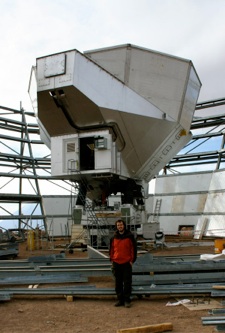Experiments
Atacama Cosmology Telescope (ACT)


The Atacama Cosmology telescope (ACT) is located at 5200 meters over the sea level, at the foot of Cerro Toco in the valley of Chajnantor, Chile. It can produce maps of the Cosmic Microwave Background (CMB) detecting anisotropies as faint as 20 micro-Kelvin at arcminute scales. Measuring the power spectrum of the CMB at these scales can help to constrain cosmological parameters like the spectral index of primordial anisotropies (ns), the non-linear growth of structure (σ8), constrain neutrino abundances, and study the re-ionization epoch. Together with this, observing at 145 GHz, 220 GHz and 280 GHz (decrement, null and increment frequencies for the Sunyaev-Zeldovich effect), it is capable of directly detecting clusters of galaxies with a small bias in redshift (it can produce a mass limited sample of clusters).

The telescope began operations in late 2007, completing 4 seasons of observations until the end of 2010. During those years it was equipped with the Millimeter Bolometer Array Camera (MBAC), a three-in-one camera containing three optic tubes illuminating a 1000-TES-bolometer array each, one per band. Detectors operate at the incredibly low temperature of 300 mK, cooled down by a pulse tube / He3 sorption fridge system. When observing, each detector is sampled 400 times per second, producing 30 TB of data per season. This enormous amount of data needs to be reduced into maps of the sky, requiring the development of a custom made data reduction pipeline. The final maps are made at UToronto using SciNet, a 3e4 core cluster requiring ~1e5 CPU hours per season of data.
In January 2011 MBAC was finally switched off, and will be replaced in 2012 by a new, polarization sensitive camera, ACTpol, much more sensitive than its predecessor.
Some Cool Instrumental Topics:
-
•Beam Characterization
-
•Atmosphere Analysis
-
•Data Analysis
External Links: